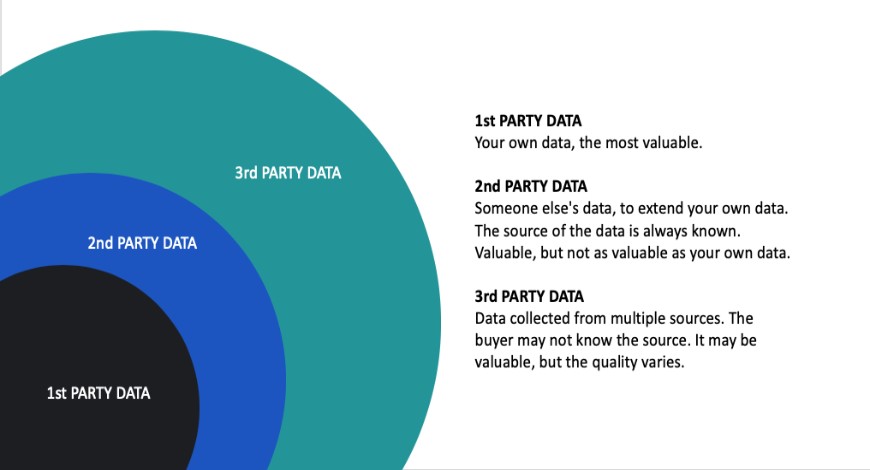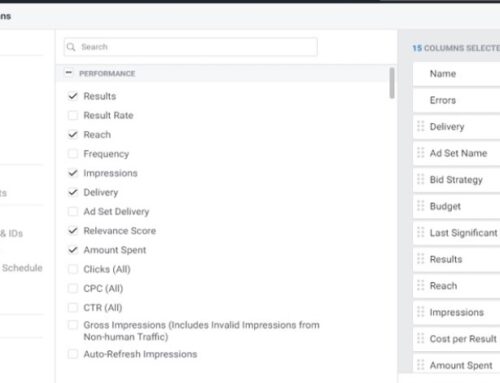What is data in advertising?
When we discuss about data in advertising, we are primarily talking about user data. We are trying to collect more information about the user, which helps us predict whether our ads will be relevant to them. Data and advertising are intertwined – like a vine growing ever higher while relying on its support. In this case, the ‘support’ is data, and the vine is ‘advertising.’
Let’s see what we mean.
The whole point of user data is to serve your ads to the right person, at the right place, and at the right time. This, in turn, reduces ad wastage and increases return on your ad campaigns. Running any advertising campaign without leveraging collected or purchased user data is like using a shotgun on a distant target. You will blow out your money before you land on a customer.
However, we have to understand that users have rising concerns about how their data is being collected. This has led to a rise of the “non-tracking approach” adopted by increasingly more users, and new privacy regulations such as GDPR and Apple’s ATT (app tracking transparency) stand in the way. We want to comply with the new data collection standards and regulations when we collect data on our users.
Let’s now look at the different types of data online.
Different types of data
When we deal with user data on the internet, it falls into any of these 3 categories. They each have their strengths and weaknesses, and many businesses use all 3 when running their advertising campaigns. Let’s take a look at them.
1st party data
1st-party data are collected directly from the owner of the site or property. This is also the most valuable, exclusive, and transparent data out of all. For example, a website can collect data on its users, like what pages they view, how long they spent on the site, any searches they performed on the site. A better one would be form submissions, product purchases, and even CRM data. These users can then be retargeted with ads, and we can ensure that a more relevant ad is served to them.
For example, a user submitting an information request on an Audi A6 sedan last week can be retargeted with relevant Audi models to keep him interested and bring him closer to the sale.
While 1st-party data can be valuable, its offsets are that it is usually the hardest to collect. Because users have to visit your site first and be interested enough to perform certain actions you deem valuable, like a form submission or product inquiry. Due to these inconveniences, 1st-party data takes time to collect; it is not something you can plug in and have it work instantly. It is also not scalable and will require 2nd and 3rd-party data to augment its value.
2nd-party data
2nd-party data is essentially someone else’s 1st-party data. You get hold of their data either through collaboration or directly purchase off them. These are reasonably accurate and retain their high quality, because it is essentially collected by someone else. However, it is also considered exclusive since this data is only accessible through individuals who have done a deal with the company selling the data and is not open to the market for all to tap on like the 3rd-party data.
2nd-party data has the advantage of helping extend the scale of your 1st-party data. However, on the downside, due to its costs and maintenance (through a DMP), it is usually only used by enterprise-level advertisers.
One example would be an online grocery store purchasing user data from MasterCard, which offers audience segments such as “Online Shopping”, further segmented into “Top Tier Spenders” or “Frequent Transactors.” These data are deemed as valuable to the online grocer since it shows user purchase intent and is likely the target audience that should be seeing their ads.
3rd-party data
3rd-party data is data you buy from outside sources that are not the original collectors of that data. There are hundreds of such data vendors, and they primarily purchase data from a wide of sources, then sort and repackage it for sale to advertisers. Most 3rd-party data is integrated into the ad ecosystem, most commonly known are Google audiences and Facebook audiences. These companies, with their behemoth level of user data collection, offer these data to advertisers and are all considered 3rd-party data.
This is the most commonly used data in advertising. Because it is the easiest to access, activate, and provides scaling user reach for advertisers. The main setback is that these data you have no direct connection with. And it is usually used in an open market setting, meaning anybody who, for instance, wanted to advertise on Facebook or Google will have access to the same audience pool as you. This includes your competitors.
The best form of 3rd-party data is usually leveraged with the advertiser’s own 1st-party data.
How are these data collected? Through the DIM method
User data on the internet is usually collected in 3 ways. We are this the DIM (Declared, Inferred, Modeled) method. Let’s look at the 3 main groups.
Declared data
Declared data is what the user willingly shares with you. This can be via registration forms, account sign-ups, subscriptions. The most obvious case of declared data comes from social media platforms. The amount of data users willingly share to social platforms like Facebook and Instagram makes them a behemoth of a data collector, and likewise very valuable for advertisers who want to advertise on their platforms. Though declared data is mostly accurate, there will still be very small instances of inaccurate data, for example, somebody putting out a false name or age.
Inferred data
Inferred data, unlike the first example, is not given by users. They are inferred or deduced based on users’ online behavior. For example, what kind of pages they browse, videos they have watched, and searches they have conducted. If a user is looking for car reviews, they are likely in the market for a new car. Or, if someone reads a lot about swimming techniques and blogs, we may infer that they are a swimming enthusiast.
Modeled data
Last but not least is modeled data. Modeled data use an extensive data set to find users matching the desired profile. For example, say you have a very valuable seed pool of audiences, and you want to check this data to similar audiences that Google or Facebook has. The most common example of modeled data is Facebook’s Lookalike Audience and Google’s Similar Audience data.
Say that you are a custom jeweler business. You upload a list of your existing customers from a CRM – Google or Facebook will use their algorithm to look at the main characteristics profile of your seed data and match to similar audiences within their data pool.
Modeled data analyzes your seed audience, identifies some key characteristics, and finds users who are similar to your target within a larger data pool. In this way, the advertiser gets to reach even more users who are similar to their past customers but may not have interacted with their business before!
In Summary
Data is the key driver to successful advertising today. Therefore, advertisers need to be armed with the knowledge of different data types and how they are collected on the internet. In this way, they will be able to leverage data and present ads in front of the right user, at the place and time. This immediately minimizes ad wastage and improves campaign returns. Isn’t it obvious that serving your ad 10 times to the right users is probably worth more than 100 times to randomly picked users on the web?
The shotgun approach is a careless and costly way to advertise online. Data control will remain the main driver for successful businesses. Having direct connections with your customers and their data will help you differentiate yourself from the crowd by serving timely, relevant, and impactful ads.





